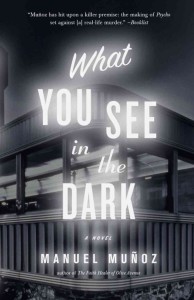Several characters construct narratives about other people in this novel. In some way, it echoes the movie making process. When an actor is playing a role, they often construct a narrative to give life to the character: what motivates them, what they fear, what they desire, their weaknesses, etc. In the book, the characters do the same. Arlene is most acutely aware of this. On page 44 she describes her own character: “She was a waitress. She was a motel owner. She was a mother. She was an abandoned wife. She served coffee. She had a brother whom she loved from a great distance, yet never saw again. Her name was Arlene. She served pie. Her name was Mrs. Watson. Her name was Arlene Watson before and after….She wanted to tell these girl waitresses to see if they would understand-that she was all of those things, and the town had a story about her and yet the story would never, ever come close to the truth (Munoz).” In other words, the whole is greater than the sum of her parts.
The younger waitresses also construct a narrative about the Actress, based on incorrect assumptions. They mistake her driver for a lover, and assume she is having an affair because their wedding rings don’t match, and they are clearly in Bakersfield for some illicit assignation. In turn, the driver makes his own assumptions about the Actress’s character. When he learns the nature of her movie character in Psycho, he is upset and let down, because her previous roles had been so wholesome. They conflate those characters she played with her own, actual personality. He and his wife constructed some narrative about who the Actress is as a person, and when those expectations are dashed, he is let down.
The townspeople also make assumptions about Teresa, and construct a narrative about her: she was nearly seventeen when her mother leaves her in town, but yet, “she learned quickly that people in Bakersfield had their own ideas about who she was and could be. Alicia’s daughter. That poor girl left alone (Munoz).” But Teresa is perfectly capable of supporting herself and living on her own.
The worst assumption though, came from Dan Watson. Although there is no evidence that Teresa ever did anything with Cheno, he assumed that she was having an affair with him and killed her in a jealous rage. The conjecture turned to gossip, which turned into the narrative of the murder: “she had been stealing money. She had been pregnant with his child. She had been caught with another man. The landlord refused to rent the apartment. He cannot get the blood off of the wall (Munoz).”
Notice that all of these assumptions are negative ones. Maybe it is human nature to ascribe the darkest motives to people and possessing negative character traits, but in this book, it works especially well as a gothic device in tandem with the movie Psycho. The dark side of human nature is what we find fascinating, hence our interest in serial killers and murder, as we discussed in class.
Works Cited
Munoz, Manuel. What You See in the Dark. Algonquin Books of Chapel Hill, 2012.


I completely agree with your interpretation of this aspect of the novel. These characters seem to be in content conflict with the town they are forced to live in and their personal space, their inner identity as individuals. They are trying to defy the identities the town imposes on them but they are not always successful. Women like Teresa, who as you mentioned is totally independent and capable of being alone, is viewed as a poor outsider to be pitied when it fact she is much more reliable, symphatetic and down to earth than Candy, an insider and thus an accepted member of the community. As a reader, this misinterpretation bothered because as I became more invested in the characters, I wanted to deny those false assumptions and defend the real identity of these women. I was particularly offended by the town’s perception of the abandoned women, Teresa and Arlene, who are seen as victims to be ostracized or degradingly protected rather than respected and treated as they would treat anyone else. The power of words, of storytelling and consequently or rumors is clearly a message of this story. All these people are shaped by the stories told by them. As Candy summarizes in what is, in my opinion, her most relevant statement: ” No, you were not there, but you could see it. And that made it a fact if you told it”.